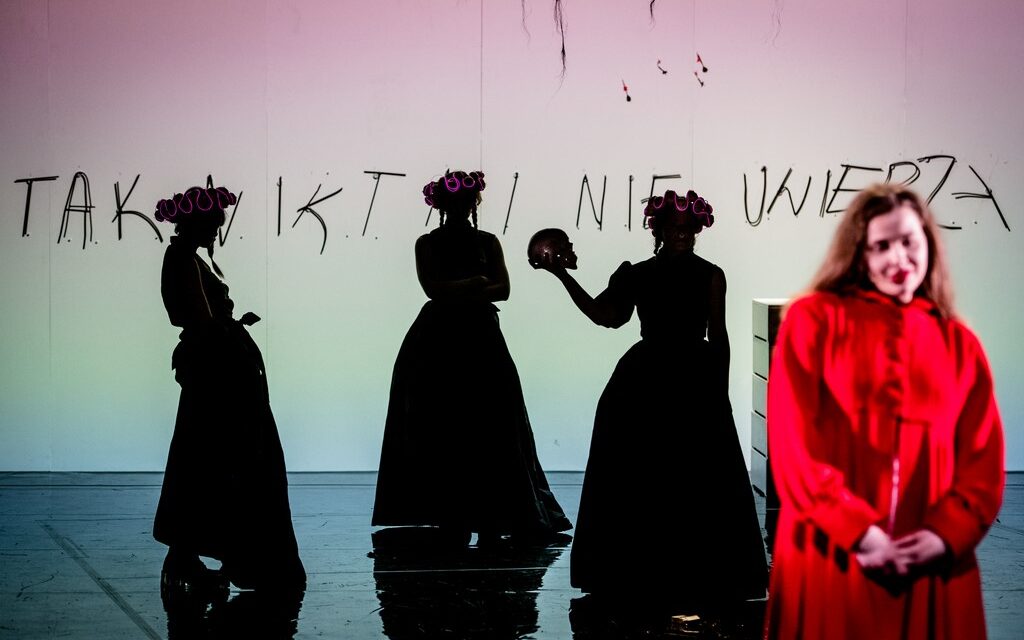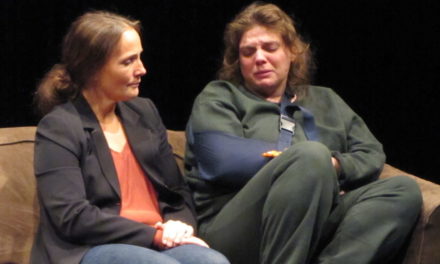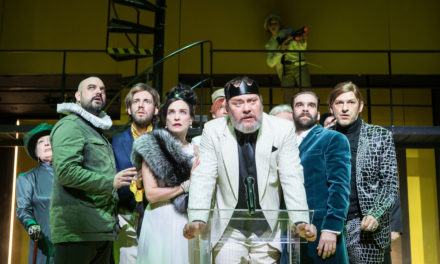“No one’s gonna believe me anyway,” says Barbara repeatedly. She knows there is no point in answering her father’s questions. The ruling surprised no one, yet she accepts it. She is not guilty of anything, but her will to resist has been broken. In Gniezno’s Fredro Theater’s production helmed by Wiktor Rubin and Jolanta Janiczak, this unmarried, luscious, and provocative shepherdess represents those who have been bullied and harassed over the centuries. Considered mentally frail, the low-born woman is turned into a scapegoat. Who will defend the sexually abused “harlot” accused of practicing witchcraft and conspiring with the devil? Her married lovers? Distanced relatives? Intimidated daughters? Perhaps it will be the town’s authorities, it’s elite, the jury, or the judge? Disenfranchised, Barbara is unable to defend herself against the accusations. She is not unlike those who were likened to lice and rats and led to the Umschlagplatz (the holding areas in occupied Poland where Jews from ghettos were assembled for deportation to death camps during the Holocaust), or refugees from the Middle East and Global South who are allowed to drown in the Mediterranean, or gay people who are stigmatized by the powers that be as a danger to Polish families. Few want to listen to the stigmatized who inspire superstition and fear.
No One’s Gonna Believe Me Anyway (I tak nikt mi nie uwierzy) is a frighteningly relevant show exploring collective ignorance ‒ a particularly acute form of violence. By depicting the suppression of victims’ voices, it connects collective ignorance to the theme of shaping history through a dominant narrative, in this instance one that sees victims as provocateurs. The play illustrates the relationship between subjectively conditioned ways of seeing, describing, remembering, and reporting events, and the version of events that is considered to be true. As a result, it depicts and exposes the mechanisms of Foucault’s power of discourse.
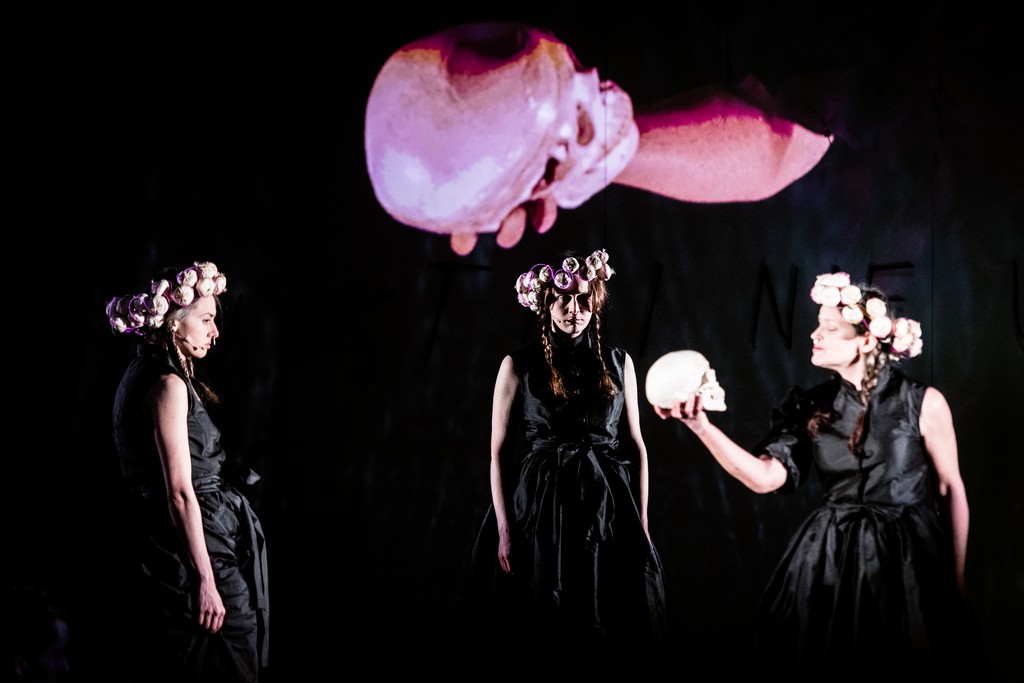
No One’s Gonna Believe Me Anyway (I tak nikt mi nie uwierzy) by Jolanta Janiczak. Directed by Wiktor Rubin for the Aleksander Fredro Theatre, Gniezno. Photo Dawid Stube.
Jolanta Janiczak was inspired by Barbara Zdunk, who is widely regarded as the last person burned at the stake in Europe. However, the play is not documentary but ‒ characteristically of Janiczak’s and Rubin’s earlier work ‒ counter-historical. Put together on the eve of the pandemic at the Fredro Theater (the lockdown delayed its opening by more than three months), the play deconstructs the narrative of a witch burned in 1811 in Rößel (now Reszel), Ermland. The creators remind us that at the root of the now-trivialized story, which is used as a local tourist attraction, there lies a real human tragedy. By processing extant information and filling the gaps with excerpts from research papers providing a psychological perspective to explain certain behaviors, they craft an alternative version of the story while remaining true to their own ethical and aesthetic principles. Like feminist theater (for example, Agnieszka Błońska’s Devils at Warsaw’s Teatr Powszechny), they combine the themes of demonic possession and female sexuality. The difference is that Rubin and Janiczak do not intend to inspire a moral revolution, but to stigmatize violence by revealing how it is distributed.
Accused of practicing witchcraft and of starting a fire to take revenge on her lover, Barbara spent four years in a prison cell. After countless rapes and many pregnancies, defamed, humiliated, and tortured, the shepherdess was put to the stake. The stage play starts after her death by her father (Roland Nowak), who seeks to reconstruct the events, guided by the principles of enlightened reason. He allows no ambiguity, uncertainty, or hesitation. Like a typical member of Poland’s current justice system, he examines all the circumstances of the case, trying to catch his daughter in a lie. He repeatedly asks questions about details. Trying to ascertain how it all started, Barbara’s father learns that when she was a girl, Barbara was raped by her uncle and later sexually abused by many other men. Her words are not enough for him, though. He keeps asking the same questions. Seeking to recreate all the circumstances of the case in detail, he initiates new scenes. Sporting white neckbands, he is his daughter’s judge, prosecutor, and defense counsel. As soon as Barbara appears to be the victim, he rejects the presumption of innocence and obliges her to explain herself. He demands convincing arguments: detailed descriptions, physical evidence, photos, and witnesses. But what Barbara remembers best are not the faces, outfits, names, times and places, but the fact she was counting in her head while she was being raped. She got to 228, 300, 400, and then she said a prayer ‒ a litany. Does the victim have to remember every detail of the traumatic event? Does she lose the right to oust bad memories and replace them with dreams of love and happiness? In these dreams she sees the cheerful Farmhand (Paweł Dobek), always accompanied by a cheerful tune (Krzysztof Kaliski’s memorable unorthodox leitmotiv), the man she would like to share her future with.
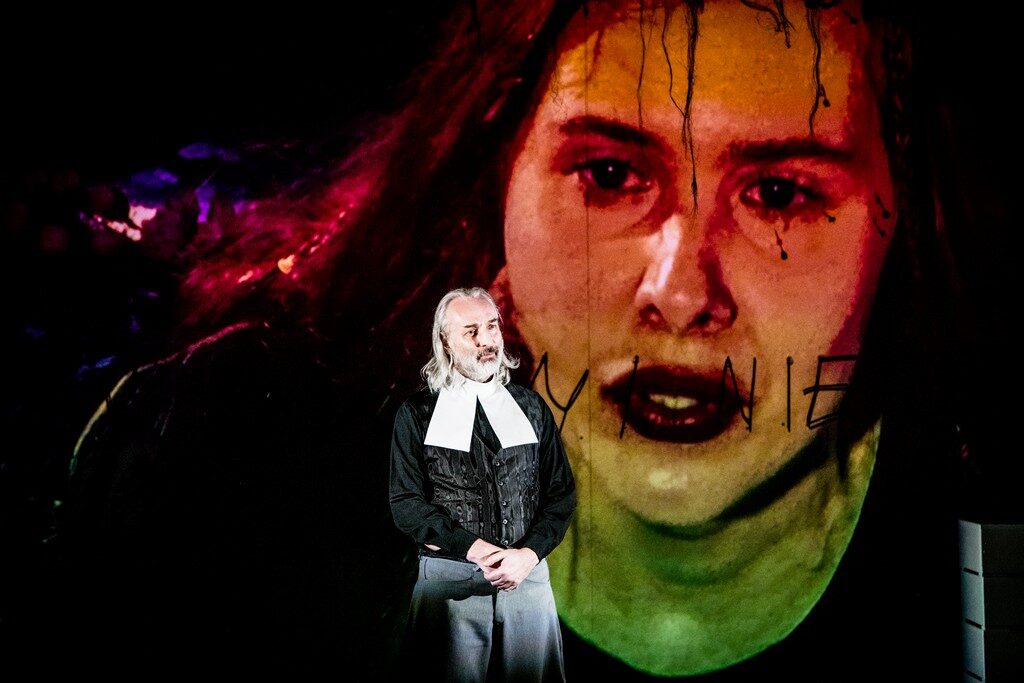
No One’s Gonna Believe Me Anyway (I tak nikt mi nie uwierzy) by Jolanta Janiczak. Directed by Wiktor Rubin for the Aleksander Fredro Theatre, Gniezno. Photo Dawid Stube.
What the characters do and say on stage is akin to a crime-scene inspection attended by the defendant; her father and re-enactors who follow the defendant’s instructions and repeat her words. The detached acting of the non-professional actors ‒ the theater’s technical team (Sławomir Grajek, Maciej Sadowski, Bogdan Stachowiak, Marcin Wojciak) ‒ imparts an aesthetic starkness to the show and stresses the constructed aspect of truth. The participants of the reenacted events are ‒ like the factual evidence collected by the defendant’s father ‒ the pieces of the puzzle that he tries to fit together. The projected live footage streamed from cameras suspended above the stage shows a collection of objects on a glass table. From time to time, among these objects, we observe bodies, the living carriers of memories, feelings and emotions reduced to the role of just another objectified piece of evidence. Can the “intellectual” male gaze, conditioned by its habits, provide an objective description of the fate of the defendant who proves to be the victim? The pressure of harmful stereotypes has curtailed women’s self-belief for centuries, limiting their independence and resistance, and making them more susceptible to violence, which is thus reinforced in a feedback loop. Rubin and Janiczak’s production explores this mechanism in action as suggested by Barbara’s father, the narrator, in the prologue: “Tonight I will invoke the findings of an experiment designed to provide insight into the loss of self-preservation instinct in women.”
The red cloak in which Barbara appears on stage is a nod to psychoanalytic readings of the story of Red Riding Hood. In them, a girl ‒ out of curiosity inspired by her newly discovered sexuality ‒ risks being “devoured” by a wolf who has designs on her virginity. The hood stands for the character’s budding femininity that, in keeping with some cultural schemata, is linked not only to frailty but also to promiscuity and infidelity. In Bruno Bettelheim’s approach, the red color symbolizes violent, sexual emotions. The red cap the girl receives from her grandmother signifies the premature transformation of a child into a person who cannot cope with her new, sexual abilities. The perspective sketched in the play transcends the limits of youthful innocence. Through masturbation, which a child can use as a lifejacket against anxiety, Barbara discovers her desires that ‒ as she matures ‒ morph into the desire for erotic intimacy. The red cloak then gives way to red boots in which Barbara steps into independent life. The boots, which once belonged to the girl’s mother, represent not only sexual maturity but also appeal to men who are keen to exploit her without asking permission.

No One’s Gonna Believe Me Anyway (I tak nikt mi nie uwierzy) by Jolanta Janiczak. Directed by Wiktor Rubin for the Aleksander Fredro Theatre, Gniezno. Photo Dawid Stube.
Barbara’s daughters (Kamila Banasiak, Martyna Rozwadowska, Joanna Żurawska) add some details to her story. Even though they all look very much alike, each provides a different point of view, broadening the overall perspective. The first admits she misses the bonds that tied their family together, attributing their disintegration to a hormonal imbalance caused by hunger. The second is ready to seek revenge on her mother’s rapists, especially the one likely to be her father. The third constructs a demonic legend, confabulating about her mother’s supernatural powers that allegedly come from Satan, who visits her in the form of a goat. There is only one person who can act as a witness for the defense ‒ Barbara’s brother ‒ but he is not entirely guilt-free either. The emotional vulnerability of this character is perfectly captured by Michał Karczewski, who subtly sketches his ambiguous sexuality. He brings to mind other supporting characters in Rubin and Janiczak’s work (Chancellor Dawid Żłobiński in Caryca Katarzyna or Esquirol Michał Pesta in Żony stanu…). The inquisitive father, even if he keeps up the façade of neutrality and objectivity, comes down on the side of the oppressors. Meanwhile, the carefree Farmhand who, whenever he enters the stage, provides a lightening of the mood and brings on a cheerful tune, seems to be a character from a different world, one imagined by Barbara. The whole cast is presented with rather challenging tasks. Karolina Staniec (Barbara, guest appearance) gives a show of determination and acting skills in her brilliant portrayal of the multihued, ambiguous character of the defendant and victim. She plays a lost woman bewildered by her sexuality but able to dream, broken by violence from which she escapes into a world of numbers and religious formulas but hiding her dramatic experiences behind a cavalier tone. At times she is detached and at times present with full awareness and corporality.
No One’s Gonna Believe Me Anyway spotlights the feedback loop of violence and the loss of credibility of its victims, which leads to further violence. The creators examine the far-reaching effects of traditional social hierarchies, which open up space for abuse and exploitation of those occupying the lower rungs of the ladder. Rubin and Janiczak make no secret of their point of view. They don’t try to equate the actions of the executioner with those of the victim, but manage to avoid one-dimensionality in creating the stage world and steer clear of the dangers of a formulaic portrayal of attitudes. Although they pile up levels of fiction by reconstructing a succession of events, the show packs an emotional punch. No One’s Gonna Believe Me Anyway is not only the title of the play but also a recurring declaration of Barbara’s beliefs, a woman who is sure that her words will make no difference. She knows that her voice, like those of many other women, will not be heard.
No One’s Gonna Believe Me Anyway (I tak nikt mi nie uwierzy) by Jolanta Janiczak
Premiered on June 19th, 2020 at the Aleksander Fredro Theatre, Gniezno
Directed by Wiktor Rubin, set design by Łukasz Surowiec and Wiktor Rubin, music by Krzysztof Kaliski.
This article was originally published in Polish by Didaskalia. Theater Journal 2020, no. 159. It was translated into English by Didaskalia and TheTheatreTimes.com and reposted with permission. The translation was supported by Polonia Aid Foundation Trust.
Didaskalia is now an open-access journal. The frequency remains unchanged and they will continue to appear bimonthly.
This post was written by the author in their personal capacity.The opinions expressed in this article are the author’s own and do not reflect the view of The Theatre Times, their staff or collaborators.
This post was written by Piotr Dobrowolski.
The views expressed here belong to the author and do not necessarily reflect our views and opinions.

